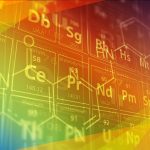Industrial ceramics, Ceramics are broadly defined as inorganic, nonmetallic materials that exhibit such useful properties as high strength and hardness, high melting temperatures, chemical inertness, and low thermal and electrical conductivity but that also display brittleness and sensitivity to flaws. As practical materials, they have a history almost as old as the human race. Traditional ceramic products, made from common, naturally occurring minerals such as clay and sand, have long been the object of the potter, the brickmaker, and the glazier. Modern advanced ceramics, on the other hand, are often produced under exacting conditions in the laboratory and call into play the skills of the chemist, the physicist, and the engineer. Containing a variety of ingredients and manipulated by a variety of processing techniques, ceramics are made into a wide range of industrial products, from common floor tile to nuclear fuel pellets. Yet all these disparate products owe their utility to a set of properties that are universally recognized as ceramic-like, and these properties in turn owe their existence to chemical bonds and atomic structures that are peculiar to the material. The composition, structure, and properties of industrial ceramics, their processing into both traditional and advanced materials, and the products made from those materials are the subject of many articles on particular traditional or advanced ceramic products, such as whitewares, abrasives, conductive ceramics, and bioceramics. For a more comprehensive understanding of the subject, however, the reader is advised to begin with the central article, on the composition, structure, and properties of ceramic materials.
Advanced ceramics
Advanced ceramics, substances and processes used in the development and manufacture of ceramic materials that exhibit special properties.
Ceramics, as is pointed out in the article ceramic composition and properties, are traditionally described as inorganic, nonmetallic solids that are prepared from powdered materials, are fabricated into products through the application of heat, and display such characteristic properties as hardness, strength, low electrical conductivity, and brittleness. Advanced ceramics represent an “advancement” over this traditional definition. Through the application of a modern materials science approach, new materials or new combinations of existing materials have been designed that exhibit surprising variations on the properties traditionally ascribed to ceramics. As a result, there are now ceramic products that are as tough and electrically conductive as some metals. Developments in advanced ceramic processing continue at a rapid pace, constituting what can be considered a revolution in the kind of materials and properties obtained.
With the development of advanced ceramics, a more detailed, “advanced” definition of the material is required. This definition has been supplied by the 1993 Versailles Project on Advanced Materials and Standards (VAMAS), which described an advanced ceramic as “an inorganic, nonmetallic (ceramic), basically crystalline material of rigorously controlled composition and manufactured with detailed regulation from highly refined and/or characterized raw materials giving precisely specified attributes.” A number of distinguishing features of advanced ceramics are pointed out in this definition. First, they tend to lack a glassy component; i.e., they are “basically crystalline.” Second, microstructures are usually highly engineered, meaning that grain sizes, grain shapes, porosity, and phase distributions (for instance, the arrangements of second phases such as whiskers and fibres) are carefully planned and controlled. Such planning and control require “detailed regulation” of composition and processing, with “clean-room” processing being the norm and pure synthetic compounds rather than naturally occurring raw materials being used as precursors in manufacturing. Finally, advanced ceramics tend to exhibit unique or superior functional attributes that can be “precisely specified” by careful processing and quality control. Examples include unique electrical properties such as superconductivity or superior mechanical properties such as enhanced toughness or high-temperature strength. Because of the attention to microstructural design and processing control, advanced ceramics often are high value-added products.

Advanced ceramics are referred to in various parts of the world as technical ceramics, high-tech ceramics, and high-performance ceramics. The terms engineering ceramics and fine ceramics are used in the United Kingdom and Japan, respectively. In this article the term advanced ceramics is used in order to distinguish the material from traditional ceramics, a category of industrial ceramics based on raw materials that are fabricated into products with comparatively little alteration from their natural state. The manufacture of traditional ceramics is covered in the article traditional ceramics.
Chemical Routes To Precursors
Like their traditional counterparts, advanced ceramics are often made by mixing and calcining (firing together) precursor powders. Unlike traditional ceramics, however, naturally occurring raw materials are seldom employed. Instead, highly pure synthetic precursors are typically used. In addition, liquid-phase sintering, a method of densifying powders that is common in traditional ceramic processing, is seldom employed. Instead, advanced ceramics are densified by transient-liquid sintering (also referred to as reactive-liquid sintering) or solid-state sintering (described later in this article). The most important factor in these sintering methods is small particle size. Small particles have a larger ratio of surface area to mass and therefore yield a higher driving force for sintering. Small particle sizes also reduce the distances over which diffusion of material must take place. Ceramists therefore take care to produce active ceramic powders with small grain size, usually in the submicrometre range—i.e., smaller than one micrometre, or one-millionth of a metre (0.000039 inch).
A major issue in the preparation of powdered precursors, especially for electroceramic applications, is chemical homogeneity—that is, the establishment of uniform chemical composition throughout the mixture. Standard solid-state techniques for processing separate precursor powders can approach homogeneity in the final product only after many grinding and firing steps. A number of chemical approaches therefore have been developed in order to improve mixing, even down to the atomic level. Often these techniques involve the decomposition of salts—for instance, carbonates, nitrates, and sulfates—into the desired chemical form. Most ceramics, as is explained in the article ceramic composition and properties, are oxides of metallic elements, although many ceramics (especially advanced ceramics) consist of carbide, nitride, and boride compounds as well. The various chemical techniques for achieving homogenous, small-grained powders are described in turn below.
Coprecipitation and freeze-drying
Often the salt compounds of two desired precursors can be dissolved in aqueous solutions and subsequently precipitated from solution by pH adjustment. This process is referred to as coprecipitation. With care, the resulting powders are intimate and reactive mixtures of the desired salts. In freeze-drying, another route to homogenous and reactive precursor powders, a mixture of water-soluble salts (usually sulfates) is dissolved in water. Small droplets are then rapidly frozen by spraying the solution into a chilled organic liquid such as hexane. With rapid freezing of the spray droplets into small ice crystals, segregation of the chemical constituents is minimized. The frozen material is removed from the hexane by sieving, and water is then removed from the ice by sublimation under vacuum.
After coprecipitation or freeze-drying the resulting powders undergo intermediate high-temperature calcination to decompose the salts and produce fine crystallites of the desired oxides.



Comments are closed